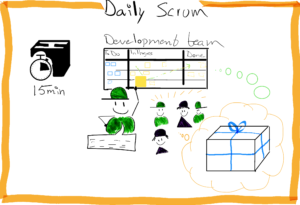Daily Scrum
Description
What is the Daily Scrum and how do you have one?
Think of the Daily Scrum as breakfast. You should start every day with it to help you make the most of the day ahead! The Daily Scrum should generate the most value with the knowledge the team has right now; each person shares what they are doing and if anything hinders them from moving toward the Sprint Goal. It is a core part of Scrum to drive implementation and align the team every working day.
Read through this recipe to find out how to make your Daily truly scrumptious!
Ingredients
- 1 Development team
- 1 Sprint board showing the Sprint tasks, physical or digital
- Optional: Notes from the previous Daily
- Optional: 1 Scrum Master
- Optional: 1 Product Owner
Preparation
Team members should be mentally prepared to share and collaborate.
Before the team starts with Scrum, set three simple rules for the Daily:
-
- Be on time
- Postpone detailed discussions until after the Daily
- End on time
Cooking method
The recipe for a Daily Scrum is simple but can take time to master! Be patient – new teams need facilitation from a Scrum Master and mature teams benefit from a Scrum Master coaching them.
- One by one, each team member gives an update on what they are working on. What they are working on should be visible and clear in the Sprint board. This update is for the team, and NOT a report to the Product Owner or Scrum Master.
- Any impediments, risks or concerns need to be shared so everyone in the team is aware.
- Focus on the Sprint Goal – the team should be working towards it
- The Scrum Master captures impediments and ensures there is a plan to address them. It is the team’s collective responsibility to resolve impediments.
- All team members should have the equal chance to speak. If discussions become too detailed or technical, protect the Daily by planning a separate meeting with those relevant.
- Enjoy the results of a good Daily: a plan for the day shared by everyone in the team that includes removing impediments.
Product Owner responsibilities
- Be available
- Don’t suggest solutions
- Be collaborative
- Negotiate the Acceptance Criteria
Scrum Master responsibilities
- Facilitate new teams. Coach mature teams
- Capture impediments
- Make sure the Daily Scrum is held every day
Developer responsibilities
- Update progress
- Highlight impediments
- Improve ways of working
- Agree how to collaborate in the best way towards the Sprint Goal
Cooking tips
- Just like a good breakfast, we know from experience that the Daily Scrum should be held every working day. Having it less frequently leads to a longer meeting, delayed decisions, and a focus on reporting to the Product Owner rather than collaborating as a team.
- Agree a time for the Daily and stick to it. Knowing that every day at the same time you have 15 minutes to focus and align with your team is very valuable and makes it easier to commit to in the long run.
- Be observant of potential command-and-control behaviours, especially when moving from a waterfall to an agile way of working. Use one-to-one coaching if that is observed.
- The work described in team members’ updates should relate to the Sprint board. If it doesn’t then that team member is possibly working on the wrong thing, or the Sprint Planning did not adequately capture what was needed for the Sprint. Use the retrospective to explore this if it happens.
- Use Sprint Retrospectives to feedback on the Daily Scrum and agree a setup the whole team is committed to.
- When there is more than one track/project/feature being worked on in parallel by the team, you can try focusing one of the Daily Scrums in the week on progress towards those specific things instead of a more general update.













